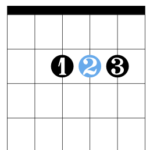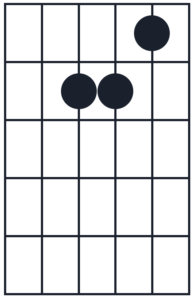How To Change Guitar Chords Smoothly

In this lesson, we will learn how to change guitar chords smoothly. This will allow you to progress faster with less fatigue in your wrists and fingers. One of the things that guitar players struggle with in the beginning is forming the chord shapes and switching between them smoothly.
You must be able to switch between them smoothly to play songs. You also want to develop good timing habits when playing music. These two things will allow you to establish yourself as a good solid rhythm player.
Up to this point
If you have been following along with my lessons, I have shown you many things associated with playing rhythm guitar. I have shown you how to play open chords. I’ve shown you how to strum chords. How to arpeggiate chords, and some basic chord theory.
If you don’t know these things or have missed these lessons, I recommend you watch them on my YouTube channel or find them here on my blog. Either way, you should know these things first, as they will provide a pre-requisite for this lesson.
Barre chords
These are not the easiest chord shapes to form in the beginning. They require all four fingers and your hand to be uncomfortable for an extended period. This requires the development of muscles in your hands, wrists, and fingers.


F major barre chord G major barre chord
The good thing about forming barre chords is that they are easy to go from chord to chord. They don’t change shape like natural chords do. Can you see that in the diagrams above? Once you get the barre chord shape down, moving them up and down the fretboard is not too difficult,
Open chords
These types of chord shapes can make it difficult to change guitar chords smoothly. The reason is that each chord has its own. This is why it is hard to switch chords in the very beginning. But a skill that you master to learn songs, or possibly write your own.


A major D major
At first, learning to form chord shapes such as A major, and D major can be tricky. But try moving between them smoothly. You put your hands and fingers in positions they are not used to. Not to mention that you are holding down metal wires on a piece of wood. So this will take some practice.
E minor to E major
The E minor chord is a great place to start because it is the easiest of all open chords to form. It only requires two fingers. And, if you form it with your middle and ring finger, you can add the index finger to create the E major chord.


E minor E major
These two chords are very popular in many songs and give you a great place to change guitar chords smoothly. You are only required to move one finger to change between them, the index finger. This is a great place to start with developing finger dexterity as well.
E major to A minor
The A minor chord is a great one to switch to next because the shape of it is the same as the E major chord. All you have to do is move the chord shape down a string. Form the E major chord, stay on the same frets, and move the shape down a string.


E major A minor
This provides a nice easy chord switch as well. Two chord shapes that are the same, but are located on two different strings. The E major is formed on the 5th string, and the A minor is on the 4th string. This makes for another great place to change guitar chords smoothly.
A minor to C major
The C major chord can be found in hundreds of popular songs. Switching to it from the A minor chord requires you to move one finger. Your ring finger on the third string 2nd fret, to the fifth string 3rd fret. The other two fingers stay where they are.


A minor C major
This not only makes for a great chord switch but also for the fact that these two chords are very common in chord progressions. You will often see these chords played one after the other in songs. Also, an idea for you if you decide to write your own.
C major to G major
The G major chord is probably the most popular open chord in all. It is present in hundreds of songs and goes well with the C major chord. These two chords are a tea in many chord progressions. If one is present, there’s a good chance the other will be there too.


C major G major
To switch to the G major chord from the C major position, you move your ring and middle finger up a string. You then take off your index finger and pace your pinky on the first string 3rd fret. This will make a quick change between these two chords.
The infamous C major chord
What’s great about the C major chord is it’s a great jump-off chord. What I mean is that you can jump to several chords from it quite easily like in the examples above. I mentioned going from A minor to C major, but you can start on C and go to A minor just as easily.
You can also jump up to G major as I’ve shown you, or jump down to the F major chord. That is what makes this chord so useful. It is a great place to start jumping to different chords quite easily. Once you get this down you can play songs with just a few chords.


C major F major
As you can see, these two chords are very similar in shape and transition quite easily. The G major, C major & F major are three chords that go together in a few popular songs. Maybe even more than that. I recommend you work on forming and switching between them.
Dive deeper
If you’d like to know more about chords and how to use them in your guitar playing, I recommend you check out the book I authored and self-published. Learn Guitar Chord Theory. Available on Amazon.
Learn Guitar Chord Theory is a comprehensive course on enjoying the fun of constructing guitar chords. It will lead you on a path to guitar chord mastery. It will teach you how to build and fully understand guitar chords in a simple step-by-step method.
Starting with the triad (three-note chord) and building up and out from there. Learn the foundation of the guitar chord, how to properly form it, what notes are needed for each key, and what’s necessary to create music with them.
Learn to play guitar chords such as majors, minors, sus2, sus4, augmented, diminished, sixth chords, dominant seventh chords, etc. In addition to all that, you’ll also learn why they are called those names. This will give you a foundation for the basics of music theory.
Yep, it’s all here and more in this book Learn Guitar Chord Theory. If you are looking to learn guitar chords in a simple easy fashion, then this book is for you. Even if you already know basic guitar chords, expanding your chord vocabulary will improve your guitar playing and also help improve your musicianship.
Packed with information that most guitar players who play by ear don’t know. Like how to read chord diagrams. How to move and add notes for creating better emotional content. This book is designed to take you from an absolute newbie (who knows nothing about guitar chords) to a well-proficient player of music knowledge and understanding.
Unlock the mysteries of the fretboard, expand your music theory, and learn concepts associated with playing guitar that professionals use. All in this comprehensive course. If you’re serious about taking your guitar playing to the next level, this method book will do it.
Private Guitar Instruction
If you form these chords and switch between them as I have shown you, you will find them easy to switch between. Once you get the basic movements down, you can jump around more effectively as songs call for it.
If you feel that private guitar lessons can help you benefit from learning the guitar, Reach out and we can get online and I can help you out with any questions or struggles you might have, Private guitar lessons are a great option because they cater to what you desire to learn.
You can go at your own pace and learn in the comfort of your own home, with a time that fits around your schedule. You will learn faster with tips and tricks from the teacher’s experience and have fun doing so. Let me know if you’re interested and I’ll get you on the schedule.
Thanks for reading and until our next lesson, take care.
Sincerely, Dwayne Jenkins
Dwayne’s Guitar Lessons

